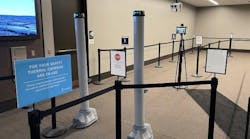WASHINGTON, D.C. -- The Transportation Security Administration (TSA) has successfully completed the explosives detection trace portal program pilot phase for passenger screening. This new technology was tested in a pilot program in 14 cities and met TSA’s rigorous standards for excellence. TSA is eager to expand this program as an important step towards increasing explosives detection capabilities at passenger screening checkpoints at our nation’s airports. Positive feedback from participating airports, airlines and passengers indicates that the technology greatly enhances customer service. Starting in July, TSA will begin the first round of deployment by adding 44 additional machines and 10 additional airports to the program.
"The explosives detection trace portal technology is a proven and valuable asset in our layered approach to aviation security, improving our ability to identify explosives," said Kenneth Kasprisin, Acting Assistant Secretary for Homeland Security for TSA. "TSA continues to seek out new technology that both enhances security and improves customer service. This technology meets those goals."
Airports in the following cities were included in the pilot program and are already using the new technology: Baltimore; Boston; Gulfport, Miss.; Jacksonville, Fla.; Las Vegas; Los Angeles; Miami; New York (JFK); Phoenix; Providence, R.I.; Rochester, N.Y.; San Francisco; San Diego; and Tampa, Fla.
By the end of September, TSA will complete the first wave of deployment of this new technology to airports in the following cities: Charlotte, N.C.; Dallas (DFW); Fort Lauderdale, Fla.; Newark, N.J.; New York (LaGuardia); Palm Beach, Fla.; Pittsburgh; San Juan, P.R.; and Washington, D.C. (both Dulles and Reagan National).
TSA continues to conduct site surveys and will announce the next round of airports to receive this technology by the end of the summer. TSA anticipates deploying 100 additional machines targeting the nation’s largest airports by January 2006.
At airports with the new technology, some passengers will be directed by TSA screeners to step into a portal at the checkpoint. Passengers will stand still for a few seconds while several "puffs" of air are released. The portal then collects and analyzes the air for traces of explosives and a computerized voice indicates when a passenger may exit.
TSA will purchase 25 trace portal machines from Smiths Detection of Pine Brook, N.J., for $3.6 million and 19 trace portals from General Electric of Wilmington, Mass., for $3.2 million. All equipment must be delivered by September. TSA is working on a procurement strategy for the next round of equipment purchases.

